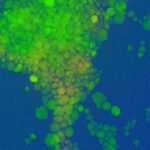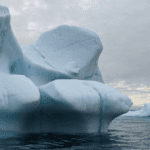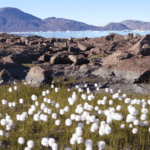Upon first glance, Dr. Kevin Mumford’s environmental engineering lab at Queen’s University in Kingston, Ontario, looks like any other laboratory with bustling graduate students working away on their research. But appearances can be deceiving, because Dr. Mumford’s group has experienced a rare occurrence in their lab: an artist became a part of their research group.
This experience was made possible through a partnership with Art the Science (ATS), a non-profit organization that facilitates artist residencies in science research spaces. This residency allows artists to expand upon their practice by providing access to scientific expertise alongside a research environment. It also provides scientists with an innovative outlet for sharing their research with the public.
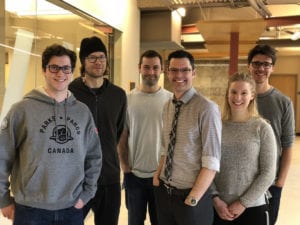
Artist Owen Fernley and several members of Dr. Kevin Mumford’s research group. (From left to right: Matan Freedman, Owen Fernley, Nick Pease, Kevin Mumford, Caroline Wisheart, and Cole Van De Ven).
Artist residencies in scientific communities are not novel. In fact, there are many notable scientific institutions and funding bodies that support these initiatives including CERN in Switzerland and the Wellcome Trust Fund in the United Kingdom. There are also interdisciplinary collaborations that are being promoted through the SciArt Center, Guerilla Science, and Beakerhead’s Big Bang Program. The arts are emerging as a popular approach to communicate science to the general public from both formal and informal learning environments.
However, according to a 2016 paper on art in science communication, whether art is effective in raising awareness or shaping public policy remains unclear. Thus, one key recommendation is to document and evaluate arts-based science communication.
Art the Science takes this into consideration by investigating the value of placing an artist into a research setting (Phase 1) and the impact of the research-based artwork on the public (Phase 2) by incorporating an evaluation plan into each residency phase.
During Phase 1, the artist is placed in an immersive scientific environment where they learn from the research team. This experience also gives scientists an opportunity to practice communicating their research to a non-expert. In Phase 2, the artist completes research-based artwork which is displayed during a public event launching the online version of the work in ATS’s digital Polyfield Gallery.
The Mumford research group hosted Phase 1 of their first science–artist residency in March, 2018. Pre- and post-residency interviews, including a daily artist video diary, were completed as part of the evaluation process to better understand the value of the scientist–artist collaboration.
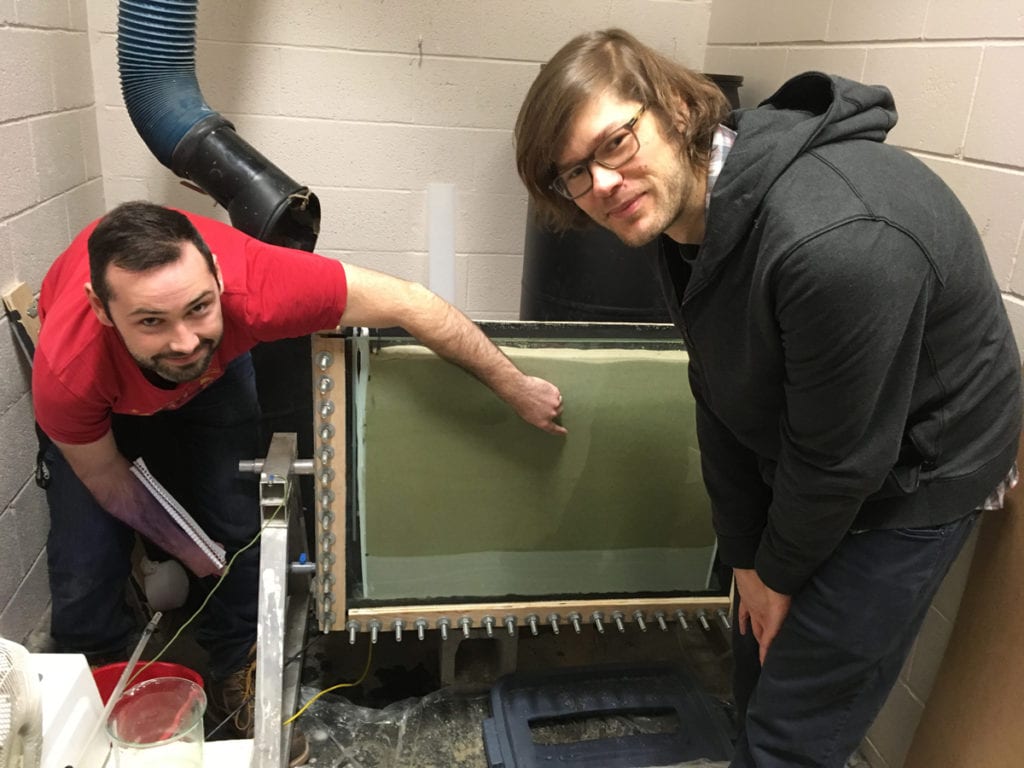
Artist Owen Fernley taking part in research group experiments with Nick Pease.
The Scientist–Artist Residency Experience
This pilot opportunity allowed artist and geophysicist Owen Fernley to expand his creative coding practice in an environmental engineering lab. In turn, Dr. Kevin Mumford gained a valuable perspective on his research. Fernley is both an artist (creative coder) and geophysical engineer who participated in several interdisciplinary collaborations, making him an ideal candidate to pilot the residency.
Fernley was immersed in a scientific lab where he had to quickly learn and understand the different ongoing research projects. Mumford’s lab is interested in the trajectory of hazardous chemicals when they are discharged into the environment as well as the remediation of contaminated sites. The group’s research projects range from mimicking how liquids and gases move through porous mediums to computer models of those processes.
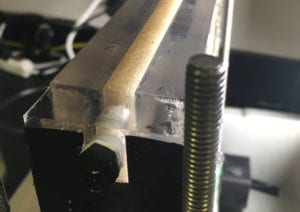
A side view of a sand-packed column from Mumford’s Civil Engineering research group.
Maximizing his time in the lab, Fernley immediately interacted with lab members asking questions and engaging in research discussions. He then absorbed the knowledge he gained and experimented with ways he could incorporate what he learned into his artwork. Although it was difficult to settle on an area of focus for his artwork, he was most inspired by the negative pore space between particles. Even though there was no expectation for the artwork to be completed during the immersive experience, Fernley felt that it was important to show his work in progress to the research group.
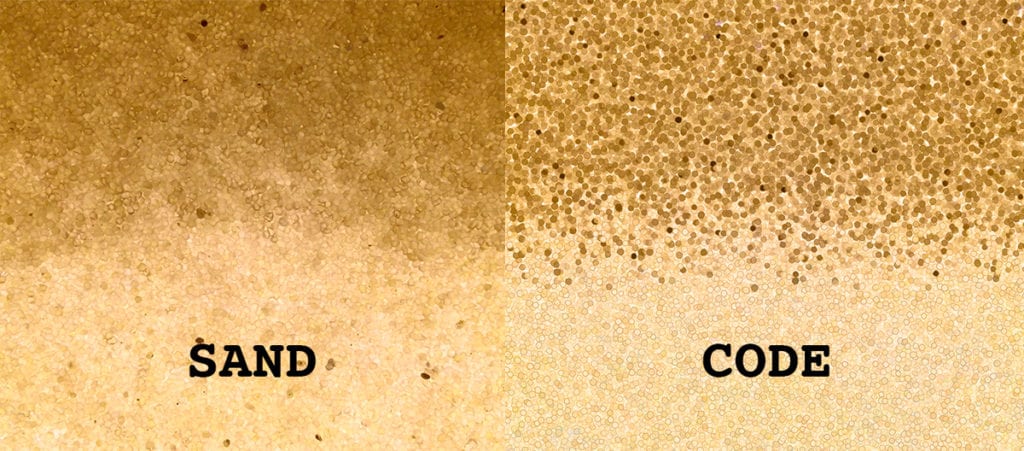
Artist Owen Fernley models a sand packed column using a custom algorithm (right) in comparison with an actual image taken from the experiment (left).
A Symbiotic Relationship
Mumford and Fernley both spoke highly of the contributions an artist could have in the research environment. For one, artists can offer a new perspective for scientists. Fernley noted that artists may notice subtleties that scientists might miss and compared this to why the human perspective is important in outer space. He recalled reading about an interesting light optic illusion during sunset that was unnoticed by technology but observed by astronauts on the space station. “A new perspective should always be welcomed, because you never know what you might find,” said Fernley.
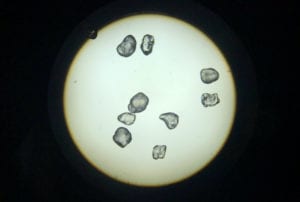
Microscope view of silica grains used in experiments observed by Owen Fernley.
Similarly, Mumford thought about how artists could encourage creative thinking in the research lab. He hoped that this residency would stimulate discussion and creative ideas, thereby fostering better problem solving. Indeed, Fernley brought in a new perspective that had a noticeable impact on Mumford’s research group.
“I saw this notion of what I viewed as additional creativity,” said Mumford. “I’ve had conversations with multiple students about how to present their data and that came out of conversations with Owen.” In addition to valuable discussions, Fernley’s presence prompted conversations with researchers outside the lab who were curious to learn about this interdisciplinary collaboration.
Fernley directly and indirectly encouraged graduate students to think about the big picture of why their research matters. As a result, they challenged themselves to think about how they communicate their research to a broader audience.
Future Residencies
In preparation for future residencies, a number of considerations need to be taken into account. Residencies need to be carefully planned to ensure that there are enough experiments happening for the artist to observe. This was indeed the case here—a result of both good luck and good management.
To support an immersive experience, artists should be given a workspace among other research group members and be included in meetings with graduate students. Although a primary graduate student was identified in this case, Fernley was able to meet with other students to help guide his thoughts during the first week of residency.
Future residencies should also involve in-depth support and facilitation to foster engagement between artists who have limited scientific background and experience with research groups. Finally, a concluding presentation from the artist should be implemented at the end of the residency to provide the research team with an overview of the artist’s experience.
Next Steps – Phase 2
Fernley is currently working on the final artwork, titled Between the Sand, which will be presented at the digital exhibition launch as part of the residency’s second phase on February 27, 2019. This event will feature a panel discussion (including Fernley, Mumford, and his graduate students) and mark the digital release of the research-based artwork into the Art the Science’s Polyfield Gallery.
In addition, an interactive installation of Between the Sand, which places the audience inside the experiment, will occur at this year’s Science Rendezvous event on May 11, 2019. Both events will take place in Kingston, Ontario. An evaluation of audience engagement during these events will be implemented, and in the meantime, the summary report of the ATS Phase 1 science-artist residency can be viewed here.

